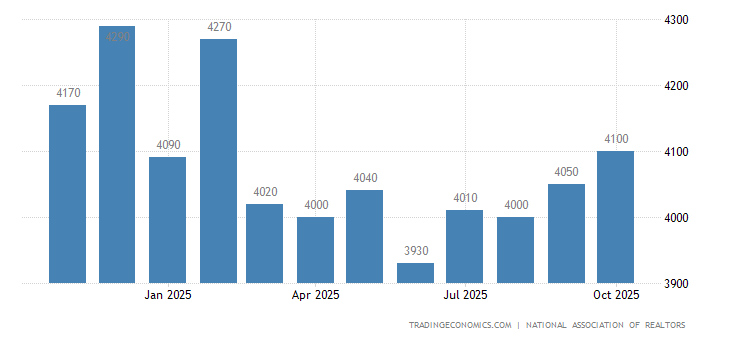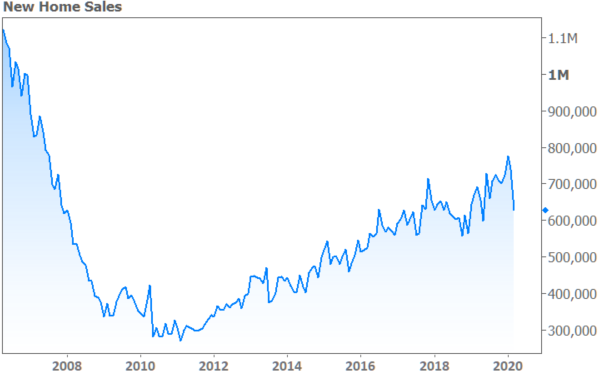Existing-home sales fell in May, marking a three-month decline in sales as a result of the coronavirus outbreak, according to the National Association of Realtors®. Each of the four major regions witnessed dips in month-over-month and year-over-year sales, with the Northeast experiencing the greatest month-over-month drop.
Total existing-home sales,1 https://www.nar.realtor/existing-home-sales, completed transactions that include single-family homes, townhomes, condominiums and co-ops, slumped 9.7% from April to a seasonally-adjusted annual rate of 3.91 million in May. Overall, sales fell year-over-year, down 26.6% from a year ago (5.33 million in May 2019).
“Sales completed in May reflect contract signings in March and April – during the strictest times of the pandemic lockdown and hence the cyclical low point,” said Lawrence Yun, NAR’s chief economist. “Home sales will surely rise in the upcoming months with the economy reopening, and could even surpass one-year-ago figures in the second half of the year.”
The median existing-home price2 for all housing types in May was $284,600, up 2.3% from May 2019 ($278,200), as prices increased in every region. May’s national price increase marks 99 straight months of year-over-year gains.
Total housing inventory3 at the end of May totaled 1.55 million units, up 6.2% from April, and down 18.8% from one year ago (1.91 million). Unsold inventory sits at a 4.8-month supply at the current sales pace, up from 4.0 months in April and up from the 4.3-month figure recorded in May 2019.
“New home construction needs to robustly ramp up in order to meet rising housing demand,” Yun said. “Otherwise, home prices will rise too fast and hinder first-time buyers, even at a time of record-low mortgage rates.”
Properties typically remained on the market for 26 days in May, seasonally down from 27 days in April, but equal to 26 days in May 2019. Fifty-eight percent of homes sold in May 2020 were on the market for less than a month.
First-time buyers were responsible for 34% of sales in May, down from 36% in April 2020 and up from 32% in May 2019. NAR’s 2019 Profile of Home Buyers and Sellers – released in late 20194 – revealed that the annual share of first-time buyers was 33%.
Individual investors or second-home buyers, who account for many cash sales, purchased 14% of homes in May, up from 10% in April 2020 and from 13% in May 2019. All-cash sales accounted for 17% of transactions in May, up from 15% in April 2020 and down from 19% in May 2019.
Distressed sales5 – foreclosures and short sales – represented 3% of sales in May, about even with April but up from 2% in May 2019.
“Although the real estate industry faced some very challenging circumstances over the last several months, we’re seeing signs of improvement and growth, and I’m hopeful the worst is behind us,” said NAR President Vince Malta, broker at Malta & Co., Inc., in San Francisco, Calif. “NAR, along with our partners and 1.4 million members, are already working to reignite America’s real estate industry, which will be a key driver in our nation’s economic recovery.”
According to Freddie Mac, the average commitment rate(link is external) for a 30-year, conventional, fixed-rate mortgage decreased to 3.23% in May, down from 3.31% in April. The average commitment rate across all of 2019 was 3.94%.
Single-family and Condo/Co-op Sales
Single-family home sales sat at a seasonally-adjusted annual rate of 3.57 million in May, down 9.4% from 3.94 million in April, and down 24.8% from one year ago. The median existing single-family home price was $287,700 in May, up 2.4% from May 2019.
Existing condominium and co-op sales were recorded at a seasonally adjusted annual rate of 340,000 units in May, down 12.8% from April and down 41.4% from a year ago. The median existing condo price was $252,300 in May, a decrease of 1.6% from a year ago.
“Relatively better performance of single-family homes in relation to multifamily condominium properties clearly suggest migration from the city centers to the suburbs,” Yun said. “After witnessing several consecutive years of urban revival, the new trend looks to be in the suburbs as more companies allow greater flexibility to work from home.”
This relocating trend can be examined further in the buying behaviors of millennials, outlined in a recent NAR report identifying the top 10 markets with opportunities for millennial homebuyers. Among other factors, the report analyzes current housing affordability and job market conditions for millennials during the pandemic. The markets – listed in alphabetical order – are Austin-Round Rock, Texas; Dallas-Fort Worth-Arlington, Texas; Des Moines-West Des Moines, Iowa; Durham-Chapel Hill-Raleigh, N.C.; Houston-The Woodlands, Texas; Indianapolis-Carmel-Anderson, Ind.; Omaha, Nebraska/Council Bluffs, Iowa; Phoenix-Mesa-Scottsdale, Ariz.; Portland, Oregon/Vancouver, Wash.; and Salt Lake City, Utah.
Regional Breakdown
As was the case for the month prior, sales for May decreased in every region from the previous month’s levels. Median home prices grew in three of the four major regions from one year ago, falling marginally in the West.
May 2020 existing-home sales in the Northeast fell 13.0%, recording an annual rate of 470,000, a 29.9% decrease from a year ago. The median price in the Northeast was $327,900, up 7.8% from May 2019.
Existing-home sales decreased 10.0% in the Midwest to an annual rate of 990,000 in May, down 20.2% from a year ago. The median price in the Midwest was $227,400, a 3.0% increase from May 2019.
Existing-home sales in the South dropped 8.0% to an annual rate of 1.73 million in May, down 25.1% from the same time one year ago. The median price in the South was $247,400, a 2.1% increase from a year ago.
Existing-home sales in the West fell 11.1% to an annual rate of 720,000 in May, a 35.1% decline from a year ago. The median price in the West was $408,400, down 0.2% from May 2019.
The National Association of Realtors® is America’s largest trade association, representing more than 1.4 million members involved in all aspects of the residential and commercial real estate industries.
# # #
For local information, please contact the local association of Realtors® for data from local multiple listing services (MLS). Local MLS data is the most accurate source of sales and price information in specific areas, although there may be differences in reporting methodology.NOTE: NAR’s Pending Home Sales Index for May is scheduled for release on June 29, and Existing-Home Sales for June will be released July 22; release times are 10:00 a.m. ET.
1 Existing-home sales, which include single-family, townhomes, condominiums and co-ops, are based on transaction closings from Multiple Listing Services. Changes in sales trends outside of MLSs are not captured in the monthly series. NAR rebenchmarks home sales periodically using other sources to assess overall home sales trends, including sales not reported by MLSs.
Existing-home sales, based on closings, differ from the U.S. Census Bureau’s series on new single-family home sales, which are based on contracts or the acceptance of a deposit. Because of these differences, it is not uncommon for each series to move in different directions in the same month. In addition, existing-home sales, which account for more than 90% of total home sales, are based on a much larger data sample – about 40% of multiple listing service data each month – and typically are not subject to large prior-month revisions.
The annual rate for a particular month represents what the total number of actual sales for a year would be if the relative pace for that month were maintained for 12 consecutive months. Seasonally adjusted annual rates are used in reporting monthly data to factor out seasonal variations in resale activity. For example, home sales volume is normally higher in the summer than in the winter, primarily because of differences in the weather and family buying patterns. However, seasonal factors cannot compensate for abnormal weather patterns.
Single-family data collection began monthly in 1968, while condo data collection began quarterly in 1981; the series were combined in 1999 when monthly collection of condo data began. Prior to this period, single-family homes accounted for more than nine out of 10 purchases. Historic comparisons for total home sales prior to 1999 are based on monthly single-family sales, combined with the corresponding quarterly sales rate for condos.
2 The median price is where half sold for more and half sold for less; medians are more typical of market conditions than average prices, which are skewed higher by a relatively small share of upper-end transactions. The only valid comparisons for median prices are with the same period a year earlier due to seasonality in buying patterns. Month-to-month comparisons do not compensate for seasonal changes, especially for the timing of family buying patterns. Changes in the composition of sales can distort median price data. Year-ago median and mean prices sometimes are revised in an automated process if additional data is received.
The national median condo/co-op price often is higher than the median single-family home price because condos are concentrated in higher-cost housing markets. However, in a given area, single-family homes typically sell for more than condos as seen in NAR’s quarterly metro area price reports.
3 Total inventory and month’s supply data are available back through 1999, while single-family inventory and month’s supply are available back to 1982 (prior to 1999, single-family sales accounted for more than 90% of transactions and condos were measured only on a quarterly basis).
4 Survey results represent owner-occupants and differ from separately reported monthly findings from NAR’s Realtors® Confidence Index, which include all types of buyers. Investors are under-represented in the annual study because survey questionnaires are mailed to the addresses of the property purchased and generally are not returned by absentee owners. Results include both new and existing homes.
read more…
nar.realtor/newsroom








